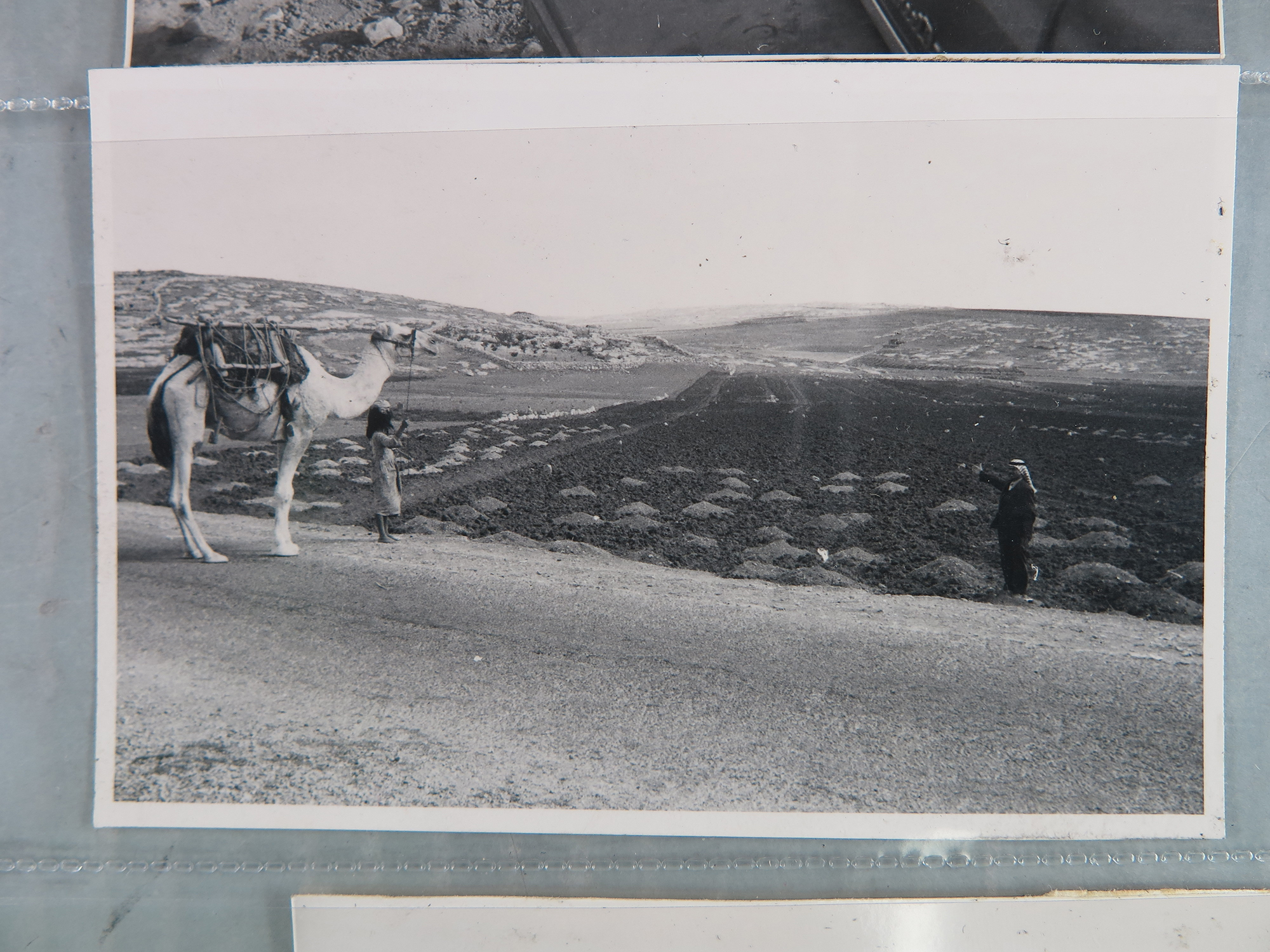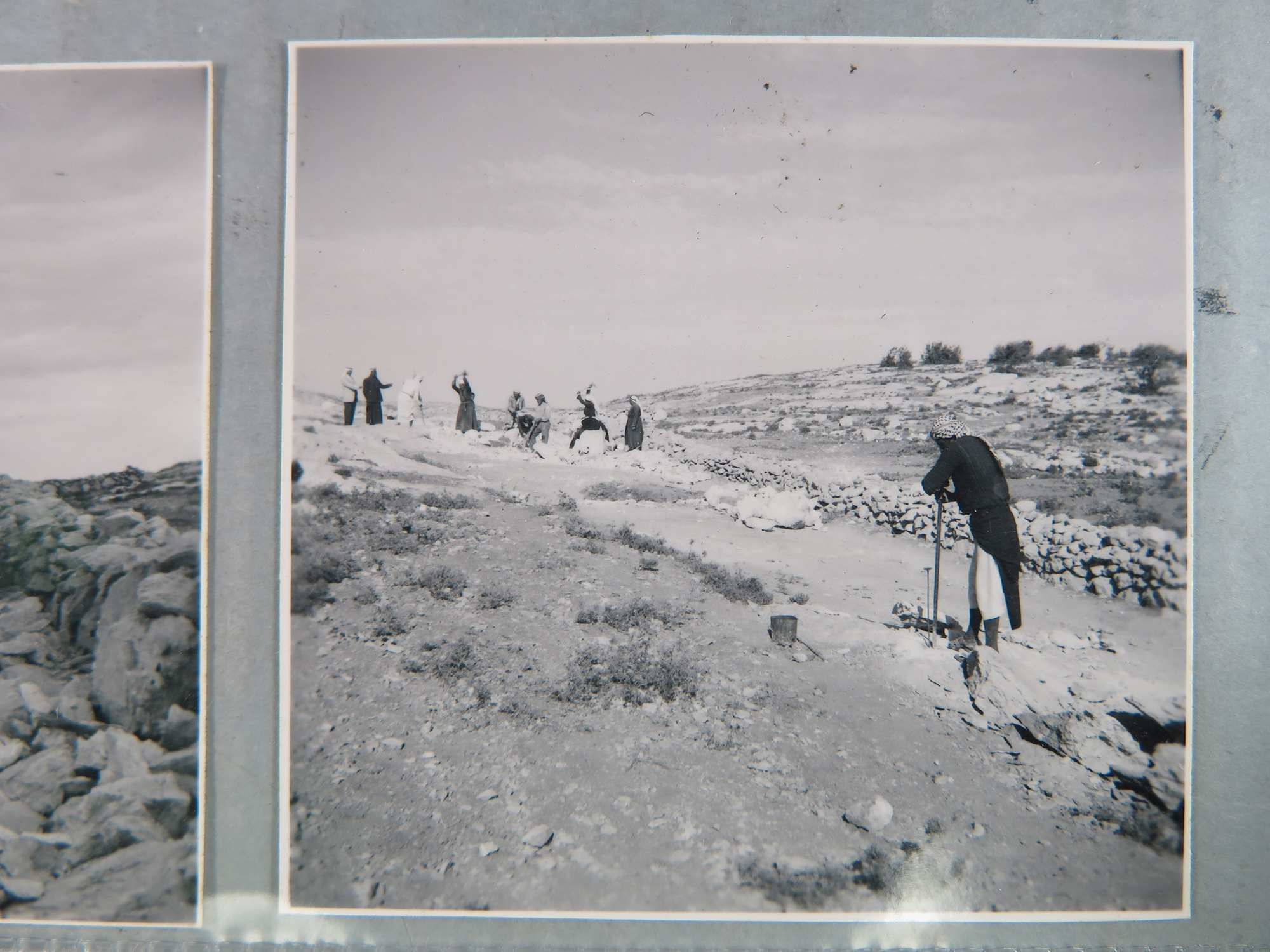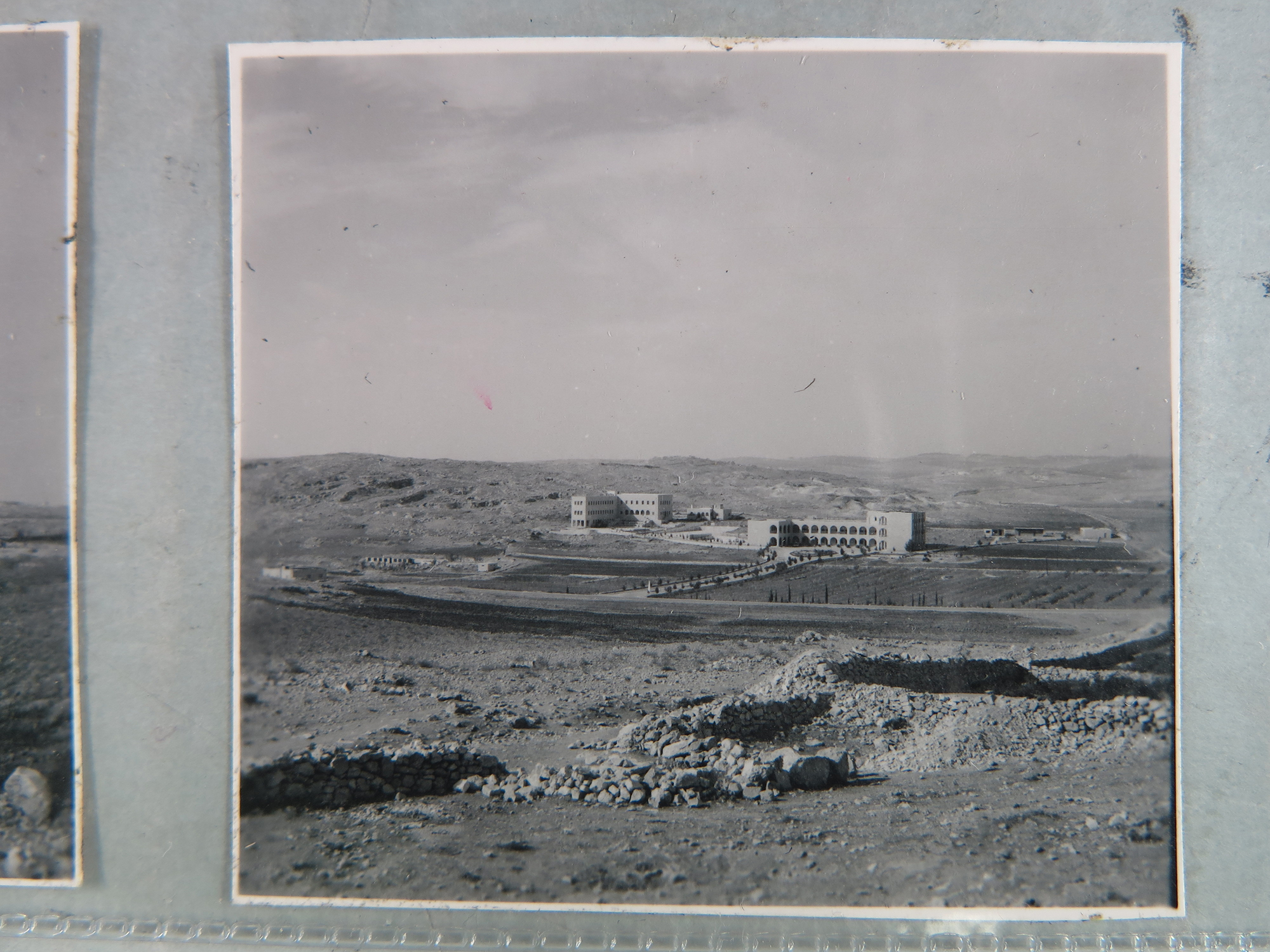Constructing the Environmental Imaginary
Share:
I wasn’t sure what I would find at the National Archives and Records Administration (NARA) in College Park, MD, but having perused their online finding aid, I had a feeling I’d discover something interesting. I spent my last day there—September 14, 2016—on the fifth floor, in the Still Picture Research Room. On the table designated to me were a pair of white cotton gloves and three gray archival boxes in which I hoped to find a few useful photographs.
But, as often happens in archives, what I found was much more exciting than expected. In the three seemingly benign boxes were 117 folders filled with thousands of photographs documenting US1 development aid to the Hashemite Kingdom of Jordan between 1953 and 1961, under President Harry S Truman’s Point Four Program. Point Four was the Marshall Plan for “underdeveloped,” or what would later be referred to as “Third World,” nations. These photographs documented an important, often overlooked period during which the US established aid programs worldwide in the name of capitalism and its ideological battle against communism.
Largely unknown, these boxes’ contents allow scholars such as myself to gain a better understanding of what US aid workers envisioned, and what they thought worthy of documentation and preservation. Through these images, we begin to understand that ideas about the environment played a crucial role in US imperial expansion during the mid-20th century. The photographs show us two things: The environment was cast as desolate; and, in contrast, technological development was presented as capable of making it better (and more like that of the US). The US environmental imaginary of Jordan had far-reaching impacts upon contemporary understanding of the environment and the daily lives of Jordanians. The USvision of development for Jordan greatly altered the socio-spatial configuration of the Jordanian landscape. These images uncover how US postwar policies on foreign development have indelibly changed the environment and, in turn, the social and ecological realms of places far beyond US borders.
Standing on the podium of the East Portico on January 20, 1949, during his second inauguration, President Truman proclaimed his vision for Point Four:
Greater production is the key to prosperity and peace. And the key to greater production is a wider and more vigorous application of modern scientific and technical knowledge.
Only by helping the least fortunate of its members to help themselves can the human family achieve the decent, satisfying life that is the right of all people.
Democracy alone can supply the vitalizing force to stir the peoples of the world into triumphant action, not only against their human oppressors, but also against their ancient enemies—hunger, misery, and despair.
On the basis of these four major courses of action we hope to help create the conditions that will lead eventually to personal freedom and happiness for all mankind.2
Archival Photographs by the Author
IMG_4353
IMG_4360
DSC_0012
IMG_3783
According to Truman, and the masterminds behind Point Four, democracy and freedom had a specific form, idea, and design: infrastructure, agriculture, food, shelter, and home economics were its tenets.
Although devised as a “bold new program,” Point Four was based upon earlier experiences by missionaries. It extracted its beliefs and ideologies from these precedents. The idea of rurality was one example. In Near East Foundation educational director Harold B. Allen’s 1953 Rural Reconstruction in Action: Experience in the Near and Middle East, heclaims that “most of the population of the world is rural.”3 At a time when trends were moving toward a massive, worldwide urbanization of populations, this focus was misguided, but it permeated the postwar US aid agents’ environmental imaginary of Jordan. Photographs of the environment systematically created this idea of a universal “rural” landscape. Through this declaration of a global rurality, Allen and other aid agents were able to draw a link between vastly different places and environments. Allen’s solution to usher nations into modernity was agriculture-based education that would make any rural landscape a productive one. Through the camera lens, aid agents saw in Jordan the familiar landscapes of the Southern US—the rivers, the hills, the slopes, and the unmechanized landscapes looked the same. Using these photographs, US aid workers projected an environmental imaginary of unproductivity, backwardness, and despair. They believed that US scientific ingenuity would remedy these “defects” and “deficiencies.”
This text brings together a selection of images from Point Four operations in Jordan. They were sourced from NARA by using four categories: infrastructure, food, agriculture, and architecture. Through these images, I share how the environment was imagined and constructed, how these ideas shaped the form of aid, and how these ideas were inherently steeped in US capitalist and imperialist ideology.
Engineered infrastructural systems played an integral part in developmental ideas of modernization. Hard infrastructure,such as bridges and roads, and soft infrastructure, such as home economic programs, were essential to making the environment and its inhabitants into modern systems and subjects. The Tennessee Valley Authority (TVA) used technical know-how to render the Tennessee River into an emblem of US scientific ingenuity, progress, and democracy—an ideal system to deploy globally.4 A TVA-based model for Jordan was conceived as a technological apparatus, as a system intended to alter Jordanian society, and as a tool for hegemonic political ends.5 Construction on the East Ghor Canal, along the Yarmouk River, began in early 1959 with the goal of harnessing the Jordan River’s hydrological potential and of creating a productive, engineered system. US engineers and administrators methodologically transformed the environment by digging, flattening, and channeling the river and its landscape into an emblem of US scientific and environmental prowess. Images documenting the construction’s progress juxtapose two narratives. The Jordanian landscape, its people, and its material culture are cast in an unruly, wild manner as actors without intention or understanding of their actions’effects. Alongside this depiction, images also tell a story about how the canal’s intervention would order the landscape, its inhabitants, and its objects in the “correct” way.
Food security and abundance were an essential part of the US campaign against communism. The inherent belief was that hunger and communism came hand in hand, and that the US could curb the driving forces behind communism by addressing global food shortages. To do so, the Point Four administrators made food production the central tenet of their global campaign. Seeds, fertilizer, surplus wheat, and experts began to circulate around the world with the aim of making the landscape productive. Point Four’s approach encapsulated the whole production-harvesting-selling-consumption food cycle. This process included field cultivation and distributing surplus wheat from the US under the PL480 program, as well as offering harvesting instructions for farmers, and home economics classes to teach their wives how to cook with the new produce.6
Point Four aid workers did not see agriculture merely as growing food and cultivating land but also as a way to reconfigure society from the ground up. It seems that in their imagination, agriculture and community development (a developmental catchall phrase encompassing different facets of aid) were the building blocks for a modern nation with modern citizens. Based upon earlier missionary ideologies (such as that of NEF, mentioned previously) and steeped in environmental determinism (and orientalism), these postwar projects drew a correlation between productive landscape and productive bodies.7 Thus, agriculture included the core concepts of cooperatives and village improvement schemes in which the existing familial and social (often tribal) relationships were dismantled and reconstructed as new industrial, productive, and quantifiable units: the farmer, the village, the cooperative.8 Such impositions were a massive endeavor that required a means to promote these new ideas. This effort included the material creation of media, such as informative posters and instructional classes; and the projects themselves, such as planting, DDT spraying, childhood education, markets, spaces, and myriad other objects that were then photographed and documented, thus becoming media in their own right. All of this was done in the name of “development.”
Whereas architects did not configure the development aid processes in Jordan, architecture played a significant role. Hospitals, laboratories, warehouses, grain stores, markets, and farms, among other buildings, were some of the first structures to be funded in Jordan by Point Four in the early 1950s. Most such structures were built to be utilitarian and efficient. This ethos also extended to schools and homes. Although there were experiments in housing, such as the PL480 homes that were finished with a dome and white stucco, most of these houses were constructed with stone and bricks. Bricks were used to make construction quick and cheap. Many of these structures did not accommodate existing socio-spatial dynamics and familial structures. Instead, they sought to unify the architecture of the built environment. Also, in these schools, the ideology of modernization, productivity, order, and uniformity was taught and imagined. In the interiors of schools and houses, women took home economics classes, where they learned what it meant to be “modern” women and mothers—the new foods they would cook, the new furniture they would use to decorate their homes, the new clothes they would wear, and the new appliances they would employ. From the inside out, architecture was the container and medium for “development.”
The image and the environment
More than seven years since I first encountered those three archival boxes, I am still fascinated by them (maybe more than I should be). I cannot escape the disparities that exist between those boxes and what I encountered “on the ground.” As I considered these images and the far-reaching impacts of what they documented, I thought that Point Four surely must factor into the collective histories and identities of Jordanians, for I could see how it shaped their environments, their architecture, and their nationhood. But when I went to Jordan for fieldwork, Point Four was a distant memory, almost forgotten by those who had lived it, and all but unknown to those who hadn’t. So, I ask myself: What can these photos do now? After more than 50 years of sitting in archives, this is the first time that they have been shown to a wider audience.
Undeniably, the colonial and imperial project of “development” has greatly shaped our contemporary understanding of the environment as something that must be engineered and productive. Focusing upon this period and “seeing” what its development agents thought was important—what they chose to document—helps us understand that the current environmental and climatic realities in which we exist are not simply accidents or a natural evolution: They were created. This product was not always made at the hands of “underdeveloped locals”; sometimes it came from foreign actors with very specific economic and political motives. This idea of an engineered landscape was inherited not only from Point Four but also from Allen and the NEF before it. Yet these ideas are not questioned as being manufactured and constructed through a methodological process of curation and imagination. These photographs document the events that allowed “development” to influence and shape the perception of the environment. They also document the systems and processes that made the environment what it is today. The landscape we see has almost become self-evident—we assume it cannot be different—but it is a creation of powers we must see to understand. Stored in acid-free, plastic sheets inside archival boxes, these images captured what made the environment, its histories, and its futures.
Dalal Musaed Alsayer is an assistant professor of architecture in the College of Architecture at Kuwait University. Her research lies at the intersection of architecture, environment, and development in the context of the Arab World during the 20th century. She is co-author, with Ricardo Camacho and Sara Saragoça Soares, of Pan-Arab Modernism: History of Architectural Practice in The Middle East, and is currently developing a manuscript based upon her dissertation, “Architecture, Environment, Development: The United States and the Making of Modern Arabia, 1949–1961,” which examines ways that US development programs sought to transform the social, environmental, and urban fabric of the Arab World. Alsayer is a co-founding editor of Current: Collective for Architecture History and Environment, a web platform that focuses upon architectural history and environment. Alsayer is co-chair, with Megan Eardley, of the Architecture and Environment interest group at the European Architectural History Network; and co-chair, with Daniel A. Barber and Joy Knoblauch, of the Society of Architectural Historians’ affiliate group, Climate Change and Architectural History.
References
| ↑1 | I use the term US instead of America/American in an attempt to write a decolonial history of US developmental aid. On this choice, see Samia Henni, “Norms and Forms of Dispossession: The Politics of Naming,” Pidgin 23 (February 2018): 16–29. |
|---|---|
| ↑2 | Harry S Truman, “Four Point Speech” (President Truman’s Second Inaugural Address, Capitol, Washington DC, January 20, 1949), online. www.trumanlibrary.org/whistlestop/50yr_archive/inagural20jan1949.htm |
| ↑3 | Harold B. Allen, Rural Reconstruction in Action: Experience in the Near and Middle East (Ithaca, NY: Cornell University Press, 1953), xi. |
| ↑4 | Avigail Sachs, The Garden in the Machine: Planning and Democracy in the Tennessee Valley Authority (Charlottesville, VA: University of Virginia Press, 2023); David Ekbladh, “‘Mr. TVA’: Grass-Roots Development, David Lilienthal, and the Rise and Fall of the Tennessee Valley Authority as a Symbol for US Overseas Development, 1933–1973,” Diplomatic History 26, no. 3 (Summer 2002): 335–374; David Ekbladh, The Great American Mission: Modernization and the Construction of an American World Order (Princeton, NJ: Princeton University Press, 2011). |
| ↑5 | For more on this episode, see Dalal Musaed Alsayer, “TVA in the Desert: US Development Projects in the Hashemite Kingdom of Jordan, 1949–1961,” in The Routledge Handbook of Infrastructure Design: Global Perspectives from Architectural History, ed. Joseph Heathcott (New York, NY: Routledge Taylor & Francis Group, 2022), 258–269. |
| ↑6 | PL480 was a development program also known as “Food For Peace” that allowed funds from selling surplus wheat to be used for other programs. See “Public Law 480: Better Than a Bomber,” Middle East Report 145 (April 1987). |
| ↑7 | See, for example, Suzana Sawyer and Arun Agrawal, “Environmental Orientalisms,” Cultural Critique 45 (Spring 2000): 71–108; Clemens Hoffmann, “Environmental Determinism as Orientalism: The Geo-Political Ecology of Crisis in the Middle East,” Journal of Historical Sociology 31, no. 1 (March 2018): 94–104, https://doi.org/10.1111/johs.12194 |
| ↑8 | On this point, see Nicole Sackley, “The Village as Cold War Site: Experts, Development, and the History of Rural Reconstruction,” Journal of Global History 6, no. 3 (November 2011): 481–504, https://doi.org/10.1017/S1740022811000428 |















































